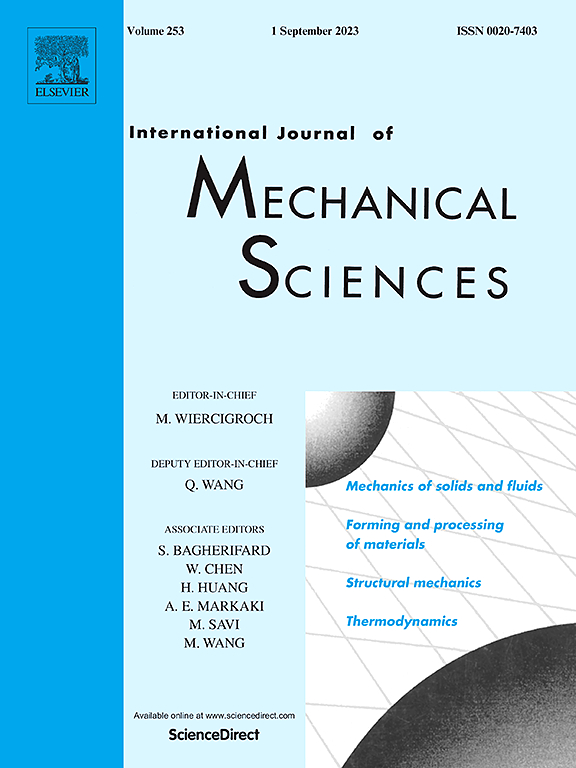Giant Shear-vertical Wave Bandgaps Induced by Diffuse Domain-walls in Ferroelectrics
IF 7.1
1区 工程技术
Q1 ENGINEERING, MECHANICAL
International Journal of Mechanical Sciences
Pub Date : 2025-04-16
DOI:10.1016/j.ijmecsci.2025.110239
引用次数: 0
Abstract
Diffuse domain walls are found to have a significant impact on the dielectric, piezoelectric, and thermal conductivity properties of ferroelectric materials. However, the influence of diffuse domain walls on the acoustic properties of ferroelectric materials has not yet been explored. In this work, we develop a phase-field perturbation model for ferroelectric materials and demonstrate that 90° diffuse domain walls can induce giant bandgaps of shear-vertical wave in bulk ferroelectrics. These giant bandgaps stem from the frequency-independent negative shear modulus localized at diffuse domain walls between adjacent domains. The bandgaps can be tuned by adjusting the periodic domain width, and the size dependence of the vibration frequency at the bandgap edges is consistent with experimental observations. Further transient dynamics analysis demonstrates that diffuse domain walls behave as freely sliding interfaces, which block the free propagation of shear-vertical waves and allow only resonant modes within a specific frequency range. The present work not only reveals the profound impact of diffuse domain walls on the propagation of elastic waves in ferroelectrics but also provides a theoretical framework for designing active and tunable sub-THz acoustic metamaterials based on ferroelectric periodic domain structures.

铁电体中漫射畴壁诱导的巨大剪切-垂直波带隙
发现漫射畴壁对铁电材料的介电、压电和导热性能有显著影响。然而,漫射畴壁对铁电材料声学特性的影响尚未得到深入研究。在这项工作中,我们建立了铁电材料的相场摄动模型,并证明了90°漫射畴壁可以在块状铁电材料中诱导剪切垂直波的巨大带隙。这些巨大的带隙源于频率无关的负剪切模量,定位于相邻域之间的扩散域壁。可以通过调节周期域宽度来调节带隙,带隙边缘处振动频率的大小依赖性与实验观察结果一致。进一步的瞬态动力学分析表明,扩散畴壁表现为自由滑动界面,它阻止了剪切垂直波的自由传播,并且只允许在特定频率范围内的共振模式。本研究不仅揭示了漫射畴壁对铁电体弹性波传播的深刻影响,而且为设计基于铁电周期畴结构的有源可调谐亚太赫兹声学超材料提供了理论框架。
本文章由计算机程序翻译,如有差异,请以英文原文为准。
求助全文
约1分钟内获得全文
求助全文
来源期刊

International Journal of Mechanical Sciences
工程技术-工程:机械
CiteScore
12.80
自引率
17.80%
发文量
769
审稿时长
19 days
期刊介绍:
The International Journal of Mechanical Sciences (IJMS) serves as a global platform for the publication and dissemination of original research that contributes to a deeper scientific understanding of the fundamental disciplines within mechanical, civil, and material engineering.
The primary focus of IJMS is to showcase innovative and ground-breaking work that utilizes analytical and computational modeling techniques, such as Finite Element Method (FEM), Boundary Element Method (BEM), and mesh-free methods, among others. These modeling methods are applied to diverse fields including rigid-body mechanics (e.g., dynamics, vibration, stability), structural mechanics, metal forming, advanced materials (e.g., metals, composites, cellular, smart) behavior and applications, impact mechanics, strain localization, and other nonlinear effects (e.g., large deflections, plasticity, fracture).
Additionally, IJMS covers the realms of fluid mechanics (both external and internal flows), tribology, thermodynamics, and materials processing. These subjects collectively form the core of the journal's content.
In summary, IJMS provides a prestigious platform for researchers to present their original contributions, shedding light on analytical and computational modeling methods in various areas of mechanical engineering, as well as exploring the behavior and application of advanced materials, fluid mechanics, thermodynamics, and materials processing.
 求助内容:
求助内容: 应助结果提醒方式:
应助结果提醒方式:


